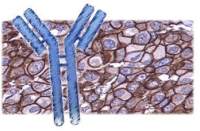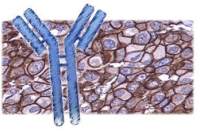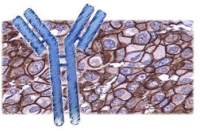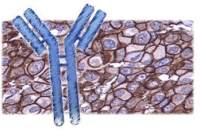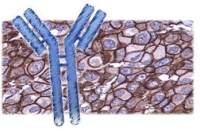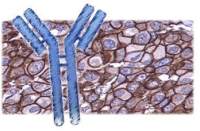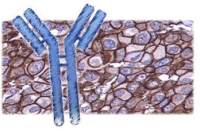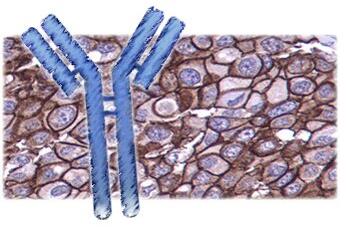
产品详情
文献和实验
相关推荐
供应商 :上海联迈生物工程有限公司
库存 :大量
靶点 :详见说明书
级别 :1
目录编号 :LM-0841R-FITC
克隆性 :多克隆
抗原来源 :Rabbit
保质期 :1年
抗体英文名 :Anti-GLP-2/FITC
抗体名 :Anti-GLP-2/FITC
标记物 :FITC标记
宿主 :Human, Mouse, Rat, Dog, Pig, Cow, Sheep,
适应物种 :Human, Mouse, Rat, Dog, Pig, Cow, Sheep,
免疫原 :详见说明书
亚型 :IGg
形态 :粉末、液体、冻干粉
应用范围 :IF=1:50-200
浓度 :1mg/ml
保存条件 :-20 °C
规格 :100ul
FITC标记的胰高血糖素样肽-2抗体| 英文名称 | Anti-GLP-2/FITC |
| 中文名称 | FITC标记的胰高血糖素样肽-2抗体 |
| 别 名 | Glucagan-like petide; glp-2; GCG; Glicentin; Glicentin related polypeptide; GLP 2; Glucagon like peptide 2; Glucagon precursor; Glucagon preproprotein; GRPP; OXM; OXY; Oxyntomodulin; GLUC_HUMAN. |
| 规格价格 | 100ul/2980元 购买 大包装/询价 |
| 说 明 书 | 100ul |
| 研究领域 | 免疫学 生长因子和激素 糖尿病 |
| 抗体来源 | Rabbit |
| 克隆类型 | Polyclonal |
| 交叉反应 | Human, Mouse, Rat, Dog, Pig, Cow, Sheep, |
| 产品应用 | IF=1:50-200 not yet tested in other applications. optimal dilutions/concentrations should be determined by the end user. |
| 分 子 量 | 20kDa |
| 性 状 | Lyophilized or Liquid |
| 浓 度 | 1mg/ml |
| 免 疫 原 | KLH conjugated synthetic peptide derived from human GLP-2 |
| 亚 型 | IgG |
| 纯化方法 | affinity purified by Protein A |
| 储 存 液 | 0.01M TBS(pH7.4) with 1% BSA, 0.03% Proclin300 and 50% Glycerol. |
| 保存条件 | Store at -20 °C for one year. Avoid repeated freeze/thaw cycles. The lyophilized antibody is stable at room temperature for at least one month and for greater than a year when kept at -20°C. When reconstituted in sterile pH 7.4 0.01M PBS or diluent of antibody the antibody is stable for at least two weeks at 2-4 °C. |
| 产品介绍 | background: The protein encoded by this gene is actually a preproprotein that is cleaved into four distinct mature peptides. One of these, glucagon, is a pancreatic hormone that counteracts the glucose-lowering action of insulin by stimulating glycogenolysis and gluconeogenesis. Glucagon is a ligand for a specific G-protein linked receptor whose signalling pathway controls cell proliferation. Two of the other peptides are secreted from gut endocrine cells and promote nutrient absorption through distinct mechanisms. Finally, the fourth peptide is similar to glicentin, an active enteroglucagon. [provided by RefSeq]. Function: Glucagon plays a key role in glucose metabolism and homeostasis. Regulates blood glucose by increasing gluconeogenesis and decreasing glycolysis. A counterregulatory hormone of insulin, raises plasma glucose levels in response to insulin-induced hypoglycemia. Plays an important role in initiating and maintaining hyperglycemic conditions in diabetes. GLP-1 is a potent stimulator of glucose-dependent insulin release. Play important roles on gastric motility and the suppression of plasma glucagon levels. May be involved in the suppression of satiety and stimulation of glucose disposal in peripheral tissues, independent of the actions of insulin. Have growth-promoting activities on intestinal epithelium. May also regulate the hypothalamic pituitary axis (HPA) via effects on LH, TSH, CRH, oxytocin, and vasopressin secretion. Increases islet mass through stimulation of islet neogenesis and pancreatic beta cell proliferation. Inhibits beta cell apoptosis. GLP-2 stimulates intestinal growth and up-regulates villus height in the small intestine, concomitant with increased crypt cell proliferation and decreased enterocyte apoptosis. The gastrointestinal tract, from the stomach to the colon is the principal target for GLP-2 action. Plays a key role in nutrient homeostasis, enhancing nutrient assimilation through enhanced gastrointestinal function, as well as increasing nutrient disposal. Stimulates intestinal glucose transport and decreases mucosal permeability. Oxyntomodulin significantly reduces food intake. Inhibits gastric emptying in humans. Suppression of gastric emptying may lead to increased gastric distension, which may contribute to satiety by causing a sensation of fullness. Glicentin may modulate gastric acid secretion and the gastro-pyloro-duodenal activity. May play an important role in intestinal mucosal growth in the early period of life. Subcellular Location: Secreted. Tissue Specificity: Glucagon is secreted in the A cells of the islets of Langerhans. GLP-1, GLP-2, oxyntomodulin and glicentin are secreted from enteroendocrine cells throughout the gastrointestinal tract. GLP1 and GLP2 are also secreted in selected neurons in the brain. Post-translational modifications: Proglucagon is post-translationally processed in a tissue-specific manner in pancreatic A cells and intestinal L cells. In pancreatic A cells, the major bioactive hormone is glucagon cleaved by PCSK2/PC2. In the intestinal L cells PCSK1/PC1 liberates GLP-1, GLP-2, glicentin and oxyntomodulin. GLP-1 is further N-terminally truncated by post-translational processing in the intestinal L cells resulting in GLP-1(7-37) GLP-1-(7-36)amide. The C-terminal amidation is neither important for the metabolism of GLP-1 nor for its effects on the endocrine pancreas. Similarity: Belongs to the glucagon family. Database links: Entrez Gene: 2641 Human Entrez Gene: 14526 Mouse Entrez Gene: 24952 Rat Omim: 138030 Human SwissProt: P01275 Human SwissProt: P55095 Mouse SwissProt: P06883 Rat Unigene: 516494 Human Unigene: 45494 Mouse Unigene: 54383 Rat Important Note: This product as supplied is intended for research use only, not for use in human, therapeutic or diagnostic applications. GLP-2是胰高血糖素原中含有的另一个胰高血糖素样肽。 |

上海联迈生物工程有限公司
品牌商实名认证
钻石会员
入驻年限:8年

